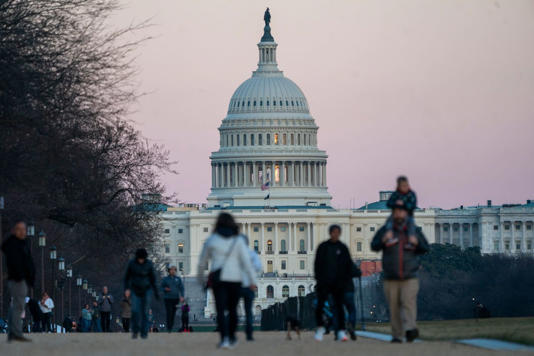The clock is ticking down to what could be a U.S. federal government shutdown like no other, with some departments set to run out of funding after this Friday and the rest to follow a week later if Congress fails to pass new legislation into law. Here’s what to expect.
What happens during a government shutdown?
In a shutdown, government offices continue essential work, but tasks deemed nonessential are put on ice, paychecks stop and many workers are furloughed until Congress passes new funding.
Why would this one be unusual?
Congress intentionally structured the deadlines so that some agencies run out of funding before others. One part of government could shut down this weekend, followed by the rest a week later.
What federal agencies risk shutting down after Friday?
With no deal, funding would expire after this Friday—12:01 a.m. Saturday—for four cabinet-level agencies: the Departments of Transportation, Housing and Urban Development, Veterans Affairs and Agriculture. Funding would also expire for smaller government divisions that provide similar services. That includes the Food and Drug Administration and the Army Corps of Engineers.
Dozens of commissions and boards, including the Tennessee Valley Authority, the National Transportation Safety Board and the Commodity Futures Trading Commission, would also be affected.
What key functions would continue?
In the event of a partial or full lapse in government funding, the government services that many Americans rely on in everyday life—Social Security payments, U.S. Postal Service mail delivery, Transportation Security Administration airport screenings—would continue. Critical services, such as work by the Energy Department to ensure nuclear reactors are safely maintained, will also be continued, as would military and border-control functions.
Two of the Agriculture Department’s main programs—grocery-store assistance from the Special Supplemental Nutrition Program for Women, Infants and Children, or WIC, program and the Supplemental Nutrition Assistance Program for low-income Americans, formerly known as food stamps—have enough money to keep operating through March, according to a USDA spokesperson.
Treasury Department officials said in their contingency plan that Internal Revenue Service employees will continue tax-return processing activities if a shutdown occurs during tax-filing season, thanks to a federal law requirement for the U.S. government to protect its property, including tax revenue.
What kind of services might be affected?
New loans for small farmers across the U.S. would be halted. Airport construction projects fueled by Transportation Department grants could become delayed.
Only a small number of Housing and Urban Development employees will be on staff to answer emergency questions and process Federal Housing Administration-insured loans, according to its contingency plan. Its rental-assistance programs wouldn’t immediately be affected.
The shutdown stands to exacerbate existing problems, such as the shortage of Federal Aviation Administration air-traffic controllers amid a concerning period for safety within the aviation industry, which has recorded a handful of near-miss accidents. Hiring new controllers would likely stop during a shutdown.
Why would only some agencies be hurt at first?
Congress funds the federal government by passing 12 appropriations bills each year, splitting up the budget among different agencies, commissions and boards. Lawmakers often miss the annual Sept. 30 deadline to pass these bills into law, prompting them to grant extensions. In November, lawmakers who crafted the second extension decided to split the appropriations bills into two buckets with separate expiration dates.
The deadline for the first-to-expire set of bills hits Friday, March 1. The next deadline comes quickly: funding for the agencies covered in the eight remaining bills expire after March 8.
While it is unusual for shutdowns to be intentionally staggered, there have been past closures that hit only a portion of federal agencies. The longest government shutdown, a 35-day affair that began on Dec. 21, 2018, only affected agencies funded through seven appropriations bills that weren’t finished by the time that date hit.
How many federal workers would be hit by the shutdown?
Roughly 630,000 federal workers would be affected by the shutdown that could begin Friday night, according to Rachel Snyderman, director of economic policy at the Bipartisan Policy Center.
When an agency runs out of money, its workers are split into two categories: essential workers who will still have to work and nonessential workers who are prohibited by law from working.
Nearly all of the affected workers—roughly 524,000 workers, or 83%—will have to continue working because their work is classified as essential, Snyderman estimates.
That high proportion of essential workers stems mostly from the Veterans Affairs Department, which will keep its medical centers, outpatient clinics and vet centers open. VA workers will continue to process and deliver benefits, though the agency will halt some services such as career counseling and transition-assistance programs and the GI Bill Hotline.
What happens to paychecks for federal workers during a shutdown?
Most federal workers, whether essential or not, won’t receive a paycheck during a government shutdown. Under a 2019 law, workers will automatically get back pay when the shutdown ends. Federal contractors who are furloughed during a shutdown aren’t guaranteed back pay.
When was the last time the federal government shutdown?
Federal agencies haven’t been hit by a funding lapse since the record-long shutdown that began in December 2018. But there have been a number of close calls. Lawmakers voted on Sept. 30 to extend government funding just hours before it was scheduled to lapse, and they have approved two other extensions since that moment with only days left before a shutdown.
What if I want to read more about these plans?
Federal agencies are required to keep shutdown contingency plans that detail how various aspects of their operations would be affected. The plan for HUD, for example, has details about how its various loan and grant programs would be affected. The White House’s Office of Management and Budget, which offers shutdown guidance for agency officials, has a list of contingency plans.
Source: The Wall Street Journal


